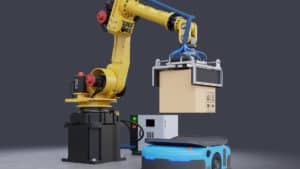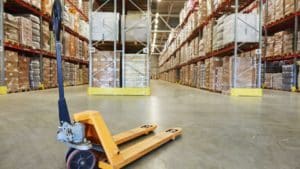If your aim is to improve the performance of your warehouse, it's imperative to understand that creating an ergonomic warehouse involves much more than the judicious organization of space. It also requires the meticulous selection of appropriate equipment, because adapting equipment to work requirements is essential. This is necessary to reduce the number of incidents and accidents, while optimizing the working environment for employees, resulting in more efficient warehouse logistics. To ensure worker safety while improving performance, it is imperative to consider two fundamental pillars: safety and ergonomics. This article explores the importance of safety and ergonomics in materials handling, with particular emphasis on the right choice of equipment.
Risks associated with handling: Understanding for effective prevention
Before exploring the safety dimension of materials handling equipment, it's essential to have a thorough understanding of the hazards to which workers are exposed. The hazards frequently associated with materials handling include musculoskeletal disorders, falls, collisions and crushing. Each of these perils is likely to have serious consequences, ranging from physical injury to costly downtime, all of which can have a detrimental effect on a company's profitability.
Recognition of these inherent handling hazards is imperative to the implementation of appropriate safety measures. These measures effectively prevent incidents likely to impact on workers' health and the company's economic performance.
Safety in materials handling: a fundamental prerogative
Safety is a fundamental aspect of materials handling, because if handling procedures are not followed, workers expose themselves to substantial risks of injury. Handling accidents can result in serious injury, costly downtime for the company and, in the most serious cases, death. It is therefore imperative that safety be given top priority in all handling operations.
Prevention in the field of materials handling encompasses the avoidance of accidents or health problems, as well as preserving the ability of the many employees prone to low-back disorders to remain at work. Once the risk has been assessed, the French Labour Code stipulates that the employer must put in place all the necessary organizational and equipment measures. This includes the use of mechanical aids, with the aim of reducing physical effort and making these operations safer. Workers must be informed of the risks involved and given practical training in the appropriate operating methods and gestures and postures to adopt to ensure safe handling.
Ergonomics: a pillar of materials handling safety
According to the Larousse dictionary, ergonomics is defined as "the quantitative and qualitative study of work in companies, aimed at improving working conditions and increasing productivity". Applied to the fields of warehousing and logistics, ergonomics encompasses a set of techniques andtools designed to facilitate operator activity while preventing risks.
The most common ergonomic problems are related to manual handling of loads, awkward postures and repetitive movements. In warehouses, ergonomic shelving aims to ensure the safety of operators, storage systems and goods handled. By combining safety and ergonomics, companies can create a safer and more productive working environment for their employees.
Handling equipment for optimum safety
Worker safety is of crucial importance in a warehouse, where risks are particularly high. To minimize accidents, three essential items of equipment must be taken into consideration:
- Safety mirrors: These are indispensable for improving operators' visibility when moving around motorized machinery, helping to reduce the risk of collisions.
- Signage accessories: Floor markings, signposts and marker cones help to improve warehouse organization and prevent accidents by highlighting high-risk areas.
- Protective clothing and equipment: Appropriate gloves, helmets, goggles, high-visibility vests and dust masks are all Personal Protective Equipment (PPE) to ensure worker safety.
When choosing equipment, it is essential to take into account the specific needs of disabled workers, whether visual or motor. Equipment must be adapted to ensure the safety of the whole team.
Handling equipment for exceptional ergonomics
Handling is a substantial part of warehouse operations. To facilitate the transport of goods while preserving workers' health, the use of ergonomic equipment is essential. The Pallet truck truck is an essential piece of equipment, enabling handlers to move heavy, bulky loads with minimal effort. This reduces the risk of musculoskeletal disorders (MSD).
To simplify the movement of goods from one point to another within the warehouse, the use of :
- Roll containers;
- Industrial trucks;
- Devils;
- Ergonomic stackers.
This equipment facilitates the transport of goods while limiting the physical strain on workers.
Fairness for all employees
It is imperative to take into account the specific needs of every employee, including those who are left-handed. Around one in ten people are left-handed, which means that equipment must be adapted to ensure their safety and efficiency. For example, providing tools specially designed for left-handers reduces the risk of injury and promotes ergonomics.
Some accessories, such as scissors or cutters, are available in right-handed, left-handed or ambidextrous versions. Several variants are recommended to ensure that all employees can work safely.
Selecting conveying equipment for handling
Choosing the right handling equipment is crucial, as it influences warehouse layout, work ergonomics, and the number of operators required. Several factors need to be considered when selecting equipment:
- The nature of the loads: It is essential to choose equipment adapted to the type of loads handled. Light loads require different equipment from heavy loads.
- The working environment: Environmental constraints, such as available space, flooring and warehouse layout, must be taken into account.
- Worker skills: Workers must be competent to use equipment safely and ergonomically. Training is therefore a key factor.
- Ergonomic needs: It's essential to choose equipment that reduces the physical strain imposed on workers, thus promoting ergonomic handling.
- Maintenance and upkeep: Equipment must be regularly serviced to ensure its proper operation and safety.
- Compliance with safety standards: Equipment must meet the safety standards in force in the region or industry.
With over 30 years of experience, Rolls Rapides is the market leader. We offer a variety of rollers, carts and handling equipment, available for hire or sale. Thanks to our design laboratory, we can create customized equipment to meet your specific requirements.









